As anyone who has read Alice in Wonderland knows, a caterpillar on a mushroom is an odd-enough sighting. 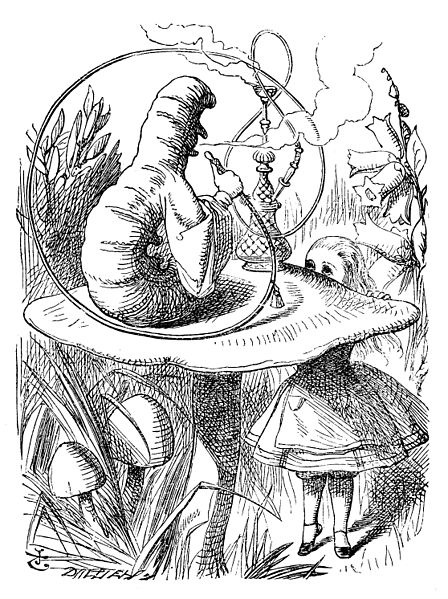
For me, it is no less odd to find a caterpillar on a mushroom in real life. I have seen exactly one. This means nothing about how common or uncommon it really is, mind you. It just means that I’ve only seen one. Ever.
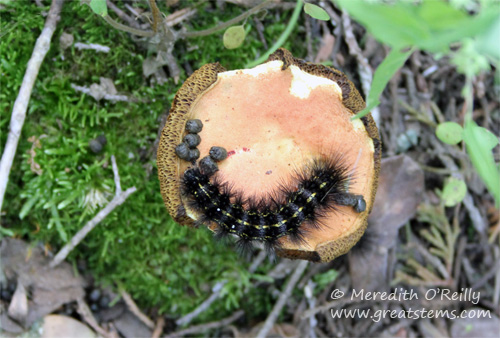 The caterpillar-on-mushroom above was found at Bright Leaf Preserve, a guided-hike-only preserve here in Austin that is truly a Wonderland itself. The caterpillar, without much investigation on my part into its actual ID but could be a Haploa moth species, looked to be consuming the mushroom, evidence being the amount of frass sitting right there on the cap. The caterpillar didn’t seem to have to move much, that’s for sure — certainly not to poop.
The caterpillar-on-mushroom above was found at Bright Leaf Preserve, a guided-hike-only preserve here in Austin that is truly a Wonderland itself. The caterpillar, without much investigation on my part into its actual ID but could be a Haploa moth species, looked to be consuming the mushroom, evidence being the amount of frass sitting right there on the cap. The caterpillar didn’t seem to have to move much, that’s for sure — certainly not to poop.
As for the mushroom, it seemed to be some type of Boletus. On the same hike, we found another mushroom of similar type:
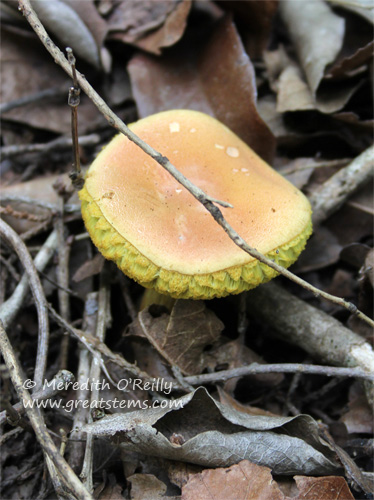
I am really struggling to ID Boletus mushrooms, so I asked for help. Sue Meltzer, author of Texas Mushrooms, told me it might be Boletus rubricitrinus, based on its reddish cap and yellow flesh. I asked about why the mushroom looked so flat, and Sue told me: “Mushrooms change during their life cycle. When fresh, they are very round, and the caps open and flatten as they mature to allow them to more efficiently disperse their spores. Picture a pretty girl lifting her skirt as she sits down until it is spread all around her. The color of the cap also fades as 1) the diameter increases, and 2) it becomes sunstruck. For a field guide, we always shoot photos of young, fresh mushrooms. That is because if you want to eat them, you should only choose them in that condition. Older mushrooms become bitter (this is also true of Portobello — I won’t buy them unless I can see that the gills are pink to pale brown. Once they are dark, they are very bitter). Also, mushrooms get attacked by insects and your caterpillar. Flies lay eggs on them which hatch into maggots. But the basic characteristics (in this case) yellow flesh and red cap; bruising to blue very quickly, are stable.” Sue, thank you! For those interested in mushrooms commonly found in Texas, Sue’s book is a wonderful and useful resource — I very much recommend it. But oh, I have so much to learn — mushrooms are not easy!
Also, a note of thanks to WiseAcre, who offered words of condolence at having mushroom ID troubles. He compared it to a “frustrating, head-banging exercise in futility.” I get that.
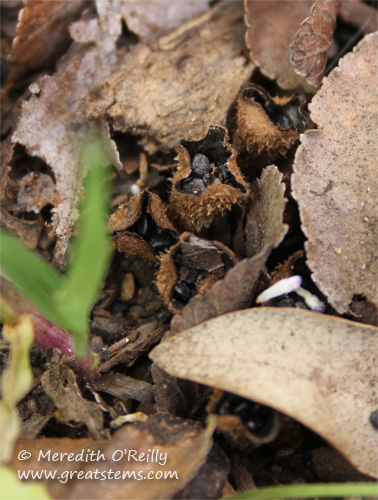 All sorts of fungi sightings have peaked my interest lately. My favorite is perhaps the Bird’s Nest Fungi growing right here in my backyard, under some poppies and other plants. These little mushrooms are so named for how they look like miniature egg-filled nests. The “eggs” are actually called peridioles, inside of which are spores. I’m amazed I noticed the tiny cups at all, and I owe it to the weeds in my garden bed that I found them, as the removal of said weeds prompted the discovery of what lay underneath.
All sorts of fungi sightings have peaked my interest lately. My favorite is perhaps the Bird’s Nest Fungi growing right here in my backyard, under some poppies and other plants. These little mushrooms are so named for how they look like miniature egg-filled nests. The “eggs” are actually called peridioles, inside of which are spores. I’m amazed I noticed the tiny cups at all, and I owe it to the weeds in my garden bed that I found them, as the removal of said weeds prompted the discovery of what lay underneath.
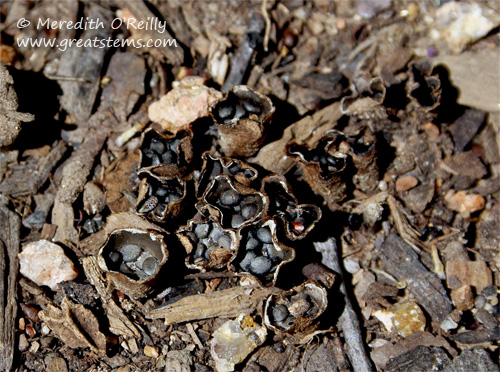
Bird’s Nest Fungi often appear in colonies, and mine were no exception. The “nests” serve as splash cups, and raindrops can easily disperse the peridioles. I ran across a video of such spore dispersal — it’s pretty nifty.
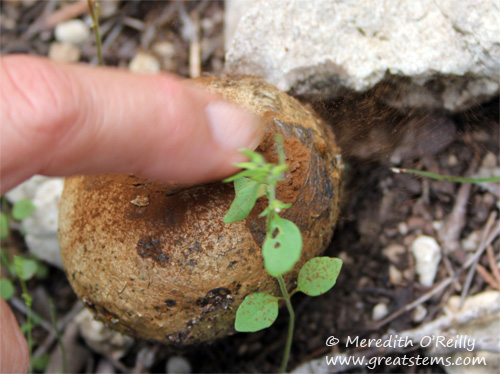 Speaking of nifty, have you seen a Puffball? If you tap on the top, a cloud of what looks like dust or smoke comes out. That so-called dust is actually the spores being dispersed. Look closely and you can see it in the picture.
Speaking of nifty, have you seen a Puffball? If you tap on the top, a cloud of what looks like dust or smoke comes out. That so-called dust is actually the spores being dispersed. Look closely and you can see it in the picture.
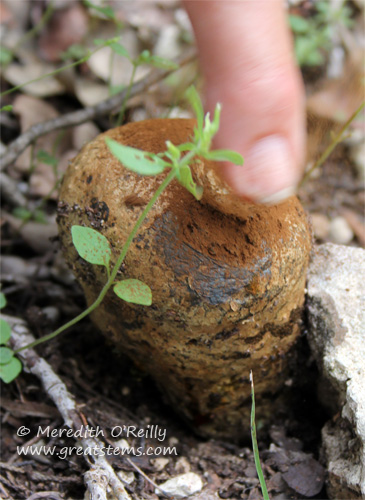 Here’s another view, again with visible spore dispersal. This Puffball was found in Bright Leaf Preserve on the same hike during which the Wonderland caterpillar was discovered.
Here’s another view, again with visible spore dispersal. This Puffball was found in Bright Leaf Preserve on the same hike during which the Wonderland caterpillar was discovered.
Fungi are fantastic, even if I do get a headache from all that banging my head in trying to ID them. Sometimes it’s even hard to know you are looking at a fungus at all!
Glad to hear the Wiseacre is back!
Always inspired by that looney bird! 🙂
Yep, ‘Shrooms are hard to ID. Which is why you should never eat them unless you are 100% sure that it’s edible…or at least that’s what I’ve always heard.
Meredith I love fungi but have mo idea what I am looking at except that it is natures art….
I am so not brave enough to eat a mushroom from the wild. I’d like to think I’d be that brave, but nope, nope, nope.
Nature has fun with mushrooms, indeed, Donna. There are some really weird ones out there!
The fungus among us is going crazy with all this rain, isn’t it? I have the indelicately named ‘dog vomit fungus’ all over my garden — purple spores everywhere! Thank goodness it’s completely harmless. I’d rather have bird’s nest fungus!
Even I would have a hard time calling “dog vomit fungus” lovely, and I say that about all sorts of gross things. Good to know that it is harmless!
I don’t know if I ever told you but lYn’s uncle was considered to be the formost authority in the world on mushrooms and fungi. All he ever wanted to talk about was mushrooms and fungi, oh yeah, you know he was a hoot to talk to…..not.
The puff ball in your last photos were always called Devil’s Snuff Box when I was a kid. Even my Grand parents in Tennessee called them that.
Oh, and it took 7 new sets of words before I could read both to respond.
I didn’t know that, Bob — about Lyn’s uncle or Devil’s Snuff Box. And I really am about to make the switch to a better blog format, just have had to wait until my schedule slows down. I have had it with this MT and the annoying comment thing.